30 East Coast Historical Sites You Need to Visit
Disclaimer: This post might contain affiliate links, which means we get a small commission if you make a purchase (at no extra cost to you).
Learn about the best historic sites, landmarks, attractions on the East Coast of the United States!
The East Coast of the United States is full of some of the best historical sites in the US. The East Coast is special as it features historic sites and landmarks that chronicle the country’s earliest history from colonization to social and political conflict. These historic sites in the US demonstrate how early American history and culture were shaped and developed throughout the centuries into what we know today. Because there are so many interesting historical sites on the East Coast, you can easily make a historical vacation out of them!
Come explore the best historical sites on the East Coast with us and plan your historical vacation!
Top East Coast Historical Sites, Attractions, and Landmarks
Acadia National Park
You may think that Maine’s Acadia National Park is nothing more than beautiful granite mountaintops and a dazzling coastline sprinkled with lush forests and ponds, but you’d be mistaken. The park boasts incredible history in addition to its stunning scenery.
Before Acadia became the first national park east of the Mississippi River, Mount Desert Island was known for its ritz and glamor. After seeing paintings of the scenery, wealthy New England families built vacation homes here and would spend their holidays and weekends on the island shores. Families included the well-known Carnegies, Astors, Morgans, Fords, Vanderbilts, and Rockefellers. Unfortunately, a great fire in 1947 consumed most of the extravagant estates.
Other than the impressive houses you will still find on the island, my favorite historical element of the park is the carriage roads. There are approximately 45 miles of these rustic, unpaved roads throughout the park. The roads were gifted to the park by John D. Rockefeller, Jr. who desired to travel Mount Desert Island on motor-free roadways. They’re popular for cycling and hiking today. My favorite aspect of the road system is the marvelous stone bridge.

For hikers who consider themselves historians, Acadia is one of the best places to visit. By 1915, there were already 200 miles of trails established on Mount Desert Island. If you walk on any of Acadia National Park’s trails, you’ll be walking in the footsteps of American Indians, early European settlers, and the wealthy elite in addition to outdoor enthusiasts like yourself
In addition to the historic elements of the park, there are plenty of things to do in Acadia. The park is popular for hiking and camping as well as auto touring and biking in addition to boat tours that focus on history and wildlife. To visit, bring your national park pass or $30 to admit your party for the week.
While most come to Acadia for the scenic views, those coastlines are layered with stories of perseverance and preservation. Every grain of sand provides insight into the lives that came before and transformed Acadia National Park into what it is today.
Contributed by Riley of the Parks Expert
Boone Hall Plantation
When visiting Charleston in South Carolina make sure you venture out of town a few miles. Just outside the city in a peaceful parkland in Mt. Pleasant, you can visit one of the oldest American plantations that still grow crops to this very day. Boone Hall Plantation is significant in American history because the plantation was lucrative and the descendants of the first owner were influential in the politics of the colonies as well as the whole country for many decades.

Boon Hall Plantation is open all year and offers tours of the property as well as the grand mansion. They also offer seasonal activities so check their website for details and dates. The cost for a single ticket is around $26 and $12 for children. Take your AAA card for discounts.
As you drive towards the grand mansion, slow down to a minimum speed to fully enjoy the ride under the majestic canopy of live oaks. It took them over two centuries to grow and connect their tops into a tunnel.
The current Boon Hall Plantation owner still lives on the top floor of the mansion, which means you’ll enjoy the guided tour of the ground level only. Besides the grand house, there is more to see. Check out the slave quarters, boathouse, crop garden, and flower garden. Don’t forget to take a selfie under the live oak trees – you’ll never forget that view.
Learn more about the Boone Hall Plantation in this awesome video by Slavka from On2Continents.com
First African Baptist Church in Savannah, GA
Founded in 1773, First African Baptist Church stands proudly in the Historic District of Savannah, Georgia, only a few steps away from the popular City Market.
The church has a long and fascinating history as both a congregation and a cultural touchstone and is one of the oldest Black congregations in the United States.
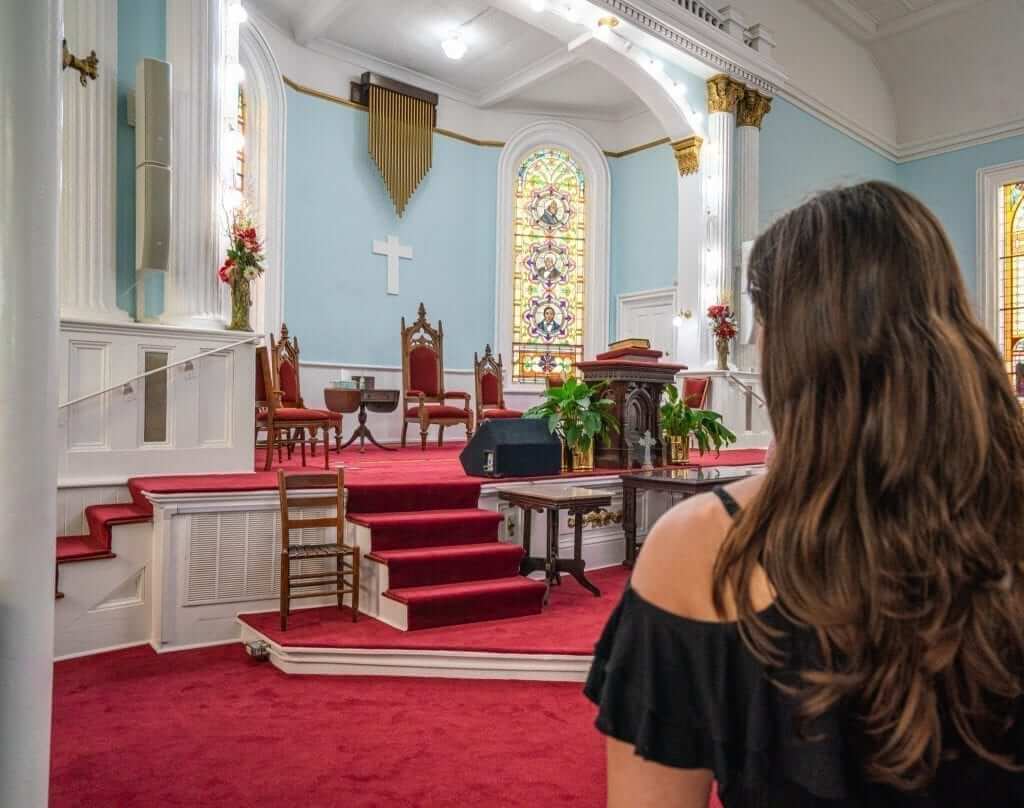
First African Baptist Church was founded and built–literally and figuratively–primarily by enslaved people, and the building itself was finished in 1859, just two years before the outbreak of the American Civil War.
Since then, the church has survived not only the Civil War, but the Reconstruction Era and the Civil Rights Movement, just to name a few.
During the 19th century, the church served as a stop on the Underground Railroad, carefully concealing people escaping slavery beneath its floorboards–today, you can still see the holes drilled into the floor that allowed those on the run to breathe while remaining concealed.
Tours of First African Baptist Church are given three times a day on Tuesday-Saturday (11am, 2pm, and 4pm), and once at 1pm on Sundays. Tours cost $10 USD.
It’s not possible to visit the interior of the church without a tour, but it’s well worth including First African Baptist Church in your Savannah itinerary, as it is a fascinating historic landmark and home to an important piece of the city’s history.
Contributed by Kate of Our Escape Clause
Learn more about some of the awesome National Parks on the East Coast!
Walter Gropius House
Significance
The home of German architect Walter Gropius and his family was built in 1938 in Massachusetts. Gropius was a revolutionary architect who founded the Bauhaus school in Germany. When he came over to the US to teach at Harvard, he designed his home himself. Gropius had a big impact on modern architecture.
What you can expect

Today, you can tour the fully furnished house. You can see the terrace he designed so his daughter could sleep under the stars and the dining room table lit by a single spot light from above so as to encourage people leaning in for lively conversation and so much more.
Even the library is still filled with Gropius’ books. They also host events, such as recitals and theme parties. For upcoming events see the Gropius House website.
Planning your visit
At the time of writing, admission for adults is $25. The Gropius House is located at 68 Baker Bridge Road, Lincoln, Mass. 01773 which is roughly a half hour drive from Boston. As of 2019 there is an app you can use to learn more about Gropius and his house, available from the website.
I visited the house in the fall, when the foliage in New England is beautifully colored. It’s a very scenic drive out from Boston through the forests, so I can highly recommend visiting during that time of year. Walter Gropius paid a lot of attention to the connection between the house and its environment, so best to go in a season when you can take full advantage of that.
Contributed by Christin of Christin has Fernweh Follow along on her Pinterest for more travel tips!
Cape Hatteras Lighthouse
Of all of the historical vacation destinations on this list, the Outer Banks is our personal favorite! The Outer Banks in North Carolina is home to many adorable (and historic!) lighthouses, but one of the most interesting and beautiful is the Cape Hatteras Lighthouse which is located in the town of Buxton. It is in the middle of the Cape Hatteras National Seashore and reachable as an easy trip from almost any Outer Banks town. The lighthouse protects an especially dangerous portion of the coastal waters where the Virginia Drift meets the Gulf Stream. Because of the dangerous waters, this is also an interesting place to scuba dive as there are many shipwrecks from the Colonial era through World War II. The lighthouse was commissioned in 1794 and completed in 1802. The current tower was built in 1868 after the original was damaged during the Civil War.
The Cape Hatteras Lighthouse no longer is in use and is listed on the National Register of Historic Places. The National Park Service operates the Hatteras Island Visitor Center and Museum of the Sea in the old lighthouse keeper’s quarters. You can also climb to the top and enjoy fabulous sea vies. The lighthouse is located at 46379 Lighthouse Road in Buxton. Tickets for entry to climb to the top are $8 for adults and $4 for children and seniors.
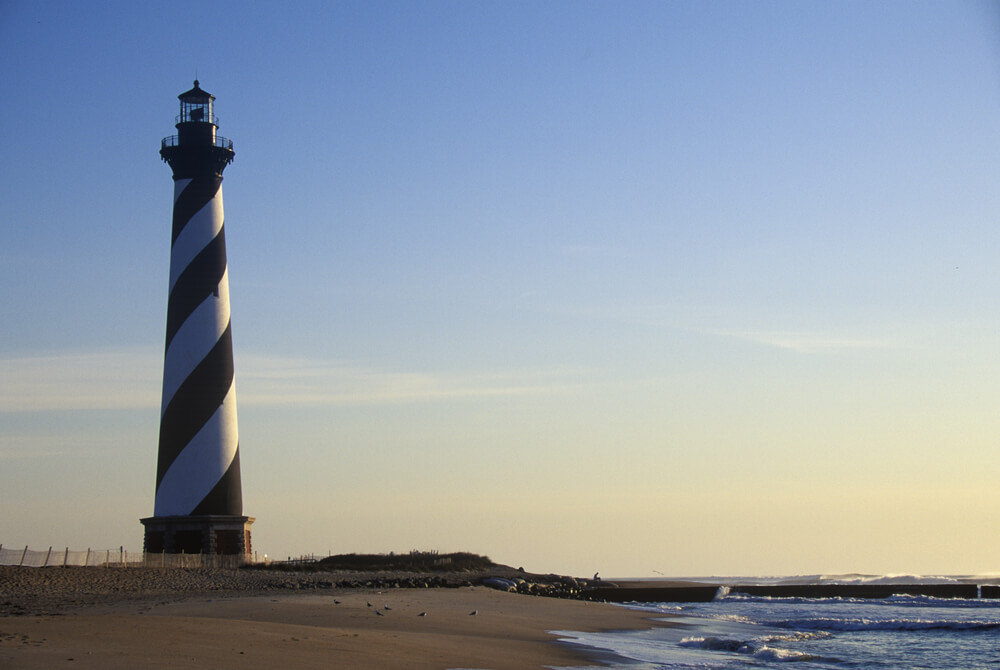
Contributed by Stephanie of the History Fangirl
The Freedom Trail
Boston, Massachusetts is one of the best cities to visit that contains so many historical sites. The Freedom Trail is one of Boston’s main historical sites. This 2.5-mile long path connects 16 historical sites across Boston. These 16 sites had a great impact on the American Revolution and the founding of the United States. There is no cost to walk the Freedom Trail and many of the sites are also free or inexpensive to get into. One of the paid sites, the Paul Revere House, charges a $5 admission fee. To get around to the stops, visitors just need to follow the brick path that easily links the sites.

I recommend starting the trail at the Bunker Hill Monument. This ensures you can climb the tower when it is less busy and you are less tired when you climb the 294 steps to the top. Make sure not to miss the museum that covers the history of the Battle of Bunker Hill. Although the Americans lost this battle, the British suffered devastating losses, thus impacting them in the war. Other must-see sites along the Freedom Trail include the USS Constitution, the oldest commissioned warship in the United States, and the site of the Boston Massacre. At the end of the Freedom Trail is the present-day state capitol building and the Boston Common, the oldest park in the United States. These sites along the Freedom Trail represent the foundations of America and portrays to visitors the process it took to become the country the United States is today.
Contributed by Francesca of Homeroom Travel. Follow along with her on Instagram
Castillo de Dan Marcos
Castillo de San Marcos is right on Matanzas Bay in St. Augustine, Florida, the oldest city in the US. It is $15 per person since it’s a walk-in park, but if you have a national park pass, that will get you in, too. There is parking at the fort, it can be used to explore the town which is very convenient, and it is $2.50 per hour. During your visit, you can do a self-guided tour of the fortress with a map and brochure, watch a demonstration by re-enactors, or do a ranger program if there is one going on. I would plan for 1-2 hours here, depending on what is going on during your visit.

So, what’s up with the fort? Well, it’s the oldest masonry fort in the US with construction beginning in 1672. 107 years after the city was founded, and while Florida was still under Spanish rule. It is made up of Coquina stones and passed through many hands and was besieged twice. However, in 1924 it was named a National Monument and after 251 years of continuous military possession, it was deactivated in 1933 and turned over to the National Park Service. Even if you’re not a huge history buff, this is a great place to visit and offers wonderful views of the bay and the city.
Contributed by Megan of Red Around the World. Follow along with her travels on Instagram
Gettysburg National Battlefield
Gettysburg is a small town located in Pennsylvania that was a key player in the American Civil War. The town dates back to 1761 when Samuel Gettys laid ground to a small tavern in the area for soldiers and merchants to rest. Gettysburg gets its true place in history as the location for one of the American Civil War’s largest battles that is known as the turning point in the war. The battle was fought July 1st to the 3rd in 1863 and saw the largest loss of life in one battle for the entire war. The battle was a win for the union and inspired the “Gettysburg Address” by President Lincoln
Gettysburg has much to offer in the form of American history. You won’t want to miss the Gettysburg National Military Park, the site of the battle. The area is largely an open field, but it has so many stories to tell. Throughout the park, you will see a number of different statues and monuments commemorating the lives lost during the battle. Tops sights to see within the Military Park include Seminary Ridge, Devil’s Den, Little Round Top, and Cemetery Ridge.

Aside from the Military Park, Gettysburg has much to offer. Visit the Jennie Wade home, the home of the only civilian killed in the battle, visit one of the many museums such as the Gettysburg Museum of History, take a ghost tour of the battlefield, or stroll main street for quaint, cute shops and great food. Be sure to try some Philly Cheesesteak while there!
Gettysburg is a fairly inexpensive destination as many of the top sights have no entrance fee. The National Military Park is free to enter as well as many of the top historical sites within the town. Many of the museums do have entrance fees, but are inexpensive. If you want to bring home some unique souvenirs the costs may add up, but a trip to Gettysburg can be done on any budget.
Contributed by Melissa of Navigation Junkie Follow along with her on Pinterest for her latest travel tips!
Fort Sumter
Fort Sumter, located on a small island in Charleston, South Carolina, was the site where the first shots of the Civil War were fired. Commonly known as the location where the Civil Wat began, a visit to Fort Sumter is perfect for those who love history.
To get to Fort Sumter, you will need to take a short (ten minute) ferry ride. Fort Sumter Tours is the only form of transportation available to the island. You can take them from Patriot’s Point (in Mount Pleasant), or Liberty Square (where the Visitor’s Center is located). While it is free to visit the National Monument, the ferry does cost $24 per adult and $16 for kids.

Once you are at the fort, there is plenty to see and explore. The fort itself is in good shape and there are many artifacts from the time (including cannons and artillery). The park rangers are there to answer any questions and sometimes offer tours. When our family visited Charleston, the rangers were very helpful and explained what happened on April 12, 1861, and Lincoln’s role during the battle. The kids participated in the Junior Ranger program and the whole family was involved in helping them complete the activities. It was a great learning experience for the entire family and a unique thing to do during our East Coast trip.
Contributed by: Margie of DQ Family Travel. Follow along with their adventures on Instagram
Mount Vernon
Mount Vernon is a must-see historic site along Virginia’s Potomac River, and is famous for being home to American’s first president. George Washington lived here starting in 1754, and was later joined by his wife, Martha, and her two children. During Washington’s residence at Mount Vernon, he served in the French and Indian War, helped America win its independence from Great Britain, and eventually was sworn in as President of the United States.
A visit to Mount Vernon provides an intimate look into the lives of the Washington family, while also showing how people lived in 18th century America. While the property consisted of 3,000 acres of land and a 3,500 square foot home when Washington first moved in, throughout his residence, he helped expand it to 7,600 acres with an 11,000 square foot mansion. A lot of this labor was done by enslaved workers living at Mount Vernon, of which there were 317 by the time of Washington’s death in 1799.
There is much to do during a visit to Mount Vernon. You can tour the Washington home, visit the Washington family tomb, explore the grounds, and learn about the slaves who lived and worked there. If you have extra time, watch the 4D film featured in the Revolutionary War Theatre, tour the museum to see the Washingtons’ personal belongings, such as George’s dentures, or dine at the Mount Vernon Inn Restaurant.

Entry to Mount Vernon costs $20 for adults, $12 for kids age 6 to 11, and free for children younger than that. It is smart to buy tickets in advance, since you will be assigned a time slot to tour the house. The earlier you book your tour the better, especially on a weekend, as crowds will swell by the afternoon.
Contributed by Theresa of Fueled By Wanderlust Follow along with her adventures on Instagram! @fueledbywanderlust
Valley Forge
It isn’t much of an exaggeration to say that if it wasn’t for that winter of 1777 in Valley Forge, the United States may not exist. At the time the Continental Army was reeling from losses, including their capital of Philadelphia, Pennsylvania. It was in December of 1777 that General George Washington and 12,000 troops encamped at a then-unknown village just outside of the capital for what would be a six-month stay.
Over that winter, the troops trained and gained new confidence. By June, the Americans were in pursuit of the British and defeated them at a battle in New Jersey. Valley Forge was, indeed, a turning point in the American Revolution.
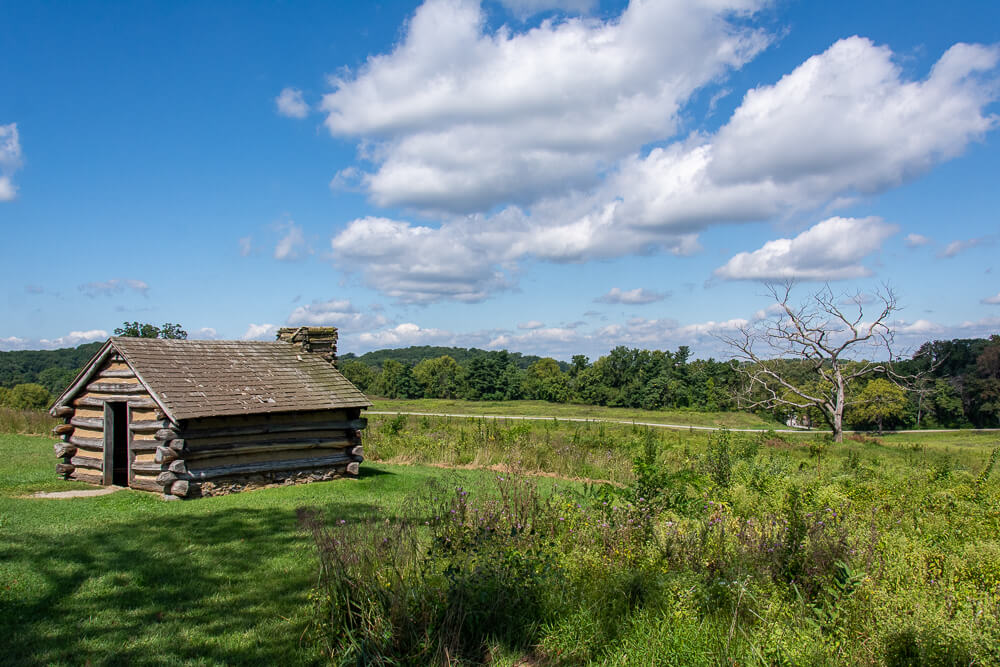
Today, 3,500 acres are preserved at Valley Forge National Historic Park for visitors to experience just want those soldiers experienced more than two centuries ago. The park is a mix of wooded areas and rolling meadows with trails meandering throughout.
Visitors can get an overview of the history at a museum that is home to artifacts found at the site. Then you can explore the site by car for the self-guided 10-mile Encampment Tour. There are parking lots throughout so that you can get on foot for a closer look at monuments (such as the massive National Memorial Arch) and reproduction log cabins. Occasionally you’ll see reenactors pop up around the park.
But don’t forget to simply enjoy this beautiful suburban park, too. Tourists tend to congregate around the historic sites but there are plenty of wooded trails to enjoy.
Entrance to Valley Forge National Historical Park is free. Trolley or bicycle tours of the site do charge a fee.
Contributed by Corinne of Reverberations. Follow along with her on Instagram!
Charleston, South Carolina
Best known for its cobblestone streets and palmetto-tree-lined streets, the city of Charleston, South Carolina is a true gem of the Southeast. Here, it’s not uncommon to hear the hooves of a horse-drawn carriage in the morning silence, or smell the scent of freshly, hand-baked buttermilk biscuits. Pastel antebellum homes contrast against clear blue skies, while visitors stroll through a city stuck back in time. Read below to find out why Charleston is consistently ranked as one of the top cities in the world.
Charleston’s Role in US History
Today, Charleston’s famous Battery Park promenade and Waterfront Park welcomes hundreds of thousands of visitors to its banks each year. However, more than 150 years ago, the area was a key component of South Carolina’s defense strategy during the Civil War. Here, Confederate soldiers placed cannons to protect against possible Union invasions. While they were were never fired, they still stand today to remind travelers of course-altering eras in American history. Across the junction of the Ashley and Cooper Rivers, one can see Fort Sumter, the spot where the first shots of the Civil War rung out.
Where to Eat, Stay, & Play in Charleston
Charleston is no stranger to great southern grub. In fact, there are so many top-ranked restaurants there, that it would be impossible to visit them all even in one week. Two hot-spots that are a must to visit are Callie’s Hot Little Biscuit (get the pimento cheese), and Husk (the menu changes based on what local farmers produce). After a good meal, stroll through downtown to Rainbow Row. Keep going straight and catch Waterfront Park at sunset — look for dolphins splashing around!

Visiting Charleston: Know Before You Go
As one of the oldest southern cities in the United States, there are endless opportunities to learn about the city’s rich cultural history just by walking. Expect to pay a bit more for accommodation and meals ($35 per day on average). Visit the official Charleston.com for information on travel restrictions and openings.
Contributed by Alexandra of East Coast Contessa.
Plimoth Plantation
Of all the places to visit on the east coast, Massachusets has the most historical vacation destinations! Plimoth Plantation in Plymouth, MA, is one of the most significant historic sites to visit on the East Coast of the United States. About 40 miles south of Boston, the town of Plymouth is the site of the famous Plymouth Rock, where the pilgrims first arrived from England in 1620 on their ship, the Mayflower. The nearby Plimoth Plantation is where they set up a village, friending the local Wampanoag residents, and where the first Thanksgiving celebration took place as a celebration of friendship and the bountiful harvest. That celebration has gone on to be one of the most important holidays in America each November.
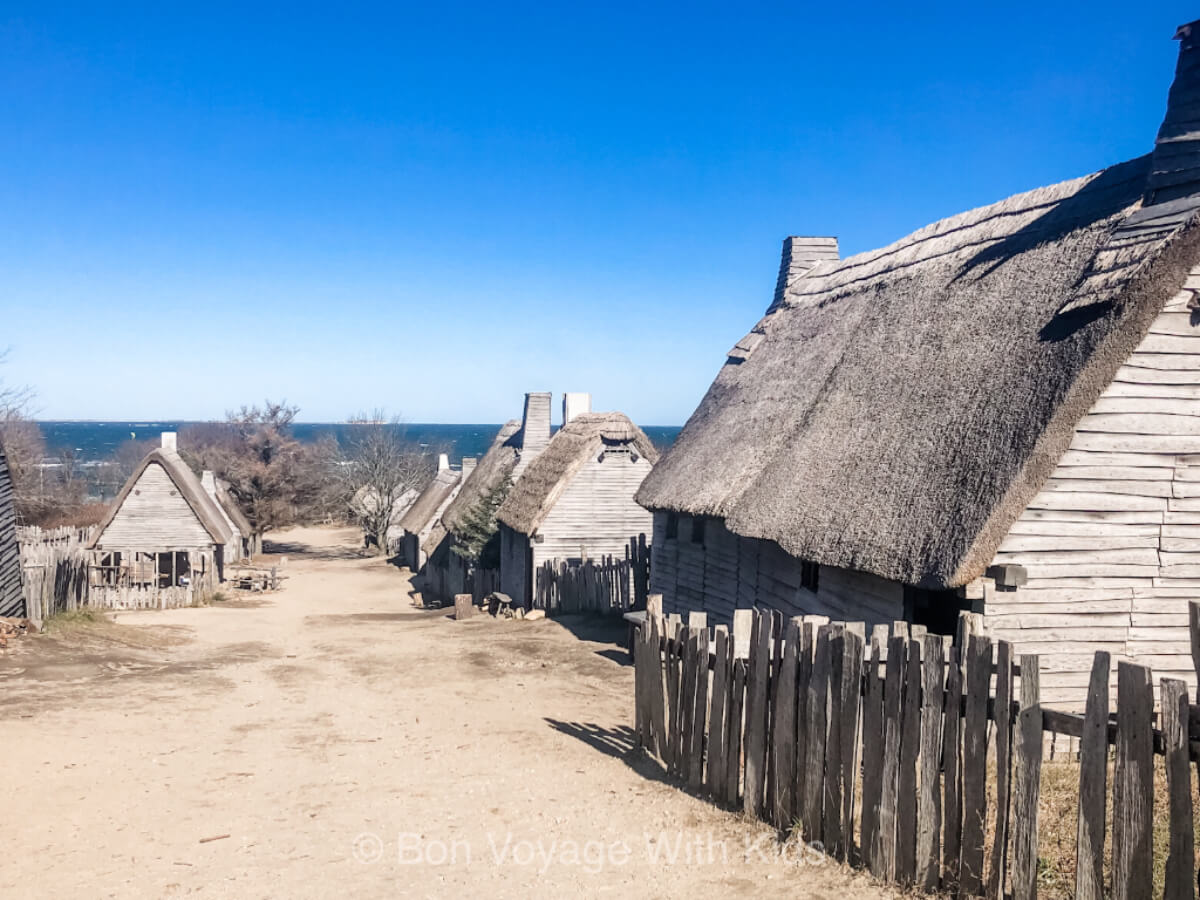
A perfect place for kids of all ages, visitors first learn about the site in the visitor center after watching a short film about the site’s history and what they will see.
From there, visitors experience the Wampanoag Homesite and structures that were typical of the Wampanoags, the Native People, whose descendants are still living in the area to this day. In fact, the Wampanoags you will meet in the Homesite are not actors. They are modern-day Native People of the Wampanoag community dressed in traditional clothing but who will speak from a modern perspective. It is a great way to interact, get an idea of what life was like for the Wampanoags during the 1600s, and ask interactive questions, but it is important to be respectful of their culture.
You can then venture into the historic 17th century English Village, which contains numerous houses you can enter. The village houses host role-playing guides dressed in period clothing acting as an English colonists of the time. The English colonists ARE actors who remain in character, though they do not perform a script. They interact as if they are in the time period and share a variety of fascinating information specific to the questions asked by the visitors. From what they are cooking to the religious beliefs of the group to all about what led to the first Thanksgiving, it is a fascinating way to learn more about such an important event in American history. My kids absolutely loved our visit, which interestingly enough was a bitterly cold day in November, giving us a first-hand experience of what life was like for the Pilgrims.
Tickets cost $32 for adults, $19 for kids ages 5-12, and $29 for seniors.
Following your visit to Plimoth Plantation, head over to see the actual Plymouth Rock and tour the Mayflower ship in downtown Plymouth. Tickets for the Mayflower are $15 for adults, $12 for kids ages 5-12, and $13.50 for seniors.
Contributed by By Keri of Bon Voyage With Kids and follow along with her on Facebook! Learn more about visiting the Boston Freedom Trail with kids!
Pilgrim Monument
One of the many things to do in Provincetown, Massachusetts is to pay a visit to the Pilgrim Monument. This historic site commemorates the first landing of the Mayflower Pilgrims in Provincetown in November 1620. What many people don’t realize is that the Pilgrims landed in Provincetown five weeks before they landed on now-famous Plymouth. Additionally, the Mayflower Compact, the first written document that referred to how the new colony would be governed, was signed aboard the ship while docked at Provincetown Harbor.
The Pilgrim Monument was built from 1907 to 1910 and can be seen from miles away. It is 252 feet tall and it is the tallest all granite structure in the US. You can climb to the top in about 10 minutes. The views from the top are quite incredible and you can almost see the Mayflower off in the distance.

The monument also has the Provincetown Museum at its base. Inside are exhibits that showcase the history of the area, including more information on the Pilgrim landing and Native American artifacts. Admission is $17 for adults and includes access to the Pilgrim Monument and Provincetown Museum. It is located in downtown Provincetown. It does have its own parking lot, but if you’ve already found a parking spot in town we suggest walking to the monument.
Contributed by Vicky of Buddy The Traveling and follow along with her on Instagram.
Harper’s Ferry West Virginia
One historical site on the East Coast that is worth a visit is Harpers Ferry National Historical Park in West Virginia. Located at the junction between the Shenandoah River and the Potomac River, Harpers Ferry is also at the crossroads of Maryland, Virginia, and West Virginia. Because of its advantageous location, as well as the railroad that went through it, this site was a hot commodity during the Civil War, changing hands eight times in four years.
Even before the Civil War, Harpers Ferry was historically significant as the site of John Brown’s Raid in 1959. John Brown was an abolitionist who attempted to start a revolt across the South by raiding the arsenal. Colonel Robert E. Lee and Stonewall Jackson were among the troops that ended the raid. For non-Civil War history, Harpers Ferry is a great place to learn about the Niagara Movement, which held its first meeting in America here, the Appalachian Trail Conservancy, headquartered here, and even a visit from Thomas Jefferson.

Harpers Ferry National Historical Park consists of the lower part of Harpers Ferry, while the Historic District is above it. Both the park and the district are laid out to mix recreations of historic buildings, events, and people with regular small-town businesses and restaurants. This, along with the free guided tours and historical markers throughout, allow for a history-rich atmosphere no matter where you are. Combine this with river views, fewer tourists, and no chain restaurants or hotels in sight, and this is the perfect historical getaway.
If you plan a visit, make sure to stay in a Bed and Breakfast, historical of course, and be aware that parking is limited. Whether you want to learn more about its history or a chance to just get away for a bit, Harpers Ferry is well worth a visit.
Contributed by Jordan of The Solo Life
Historic Jamestown
Jamestown, Virginia, was the site of the first permanent English settlement in the New World, founded in 1607. From that tiny colonial foothold in North America came so much of the good (representative government) and the bad (slavery, conflict with Native Americans) that makes up American history. This is where it all started.
Historic Jamestowne, unlike the Jamestown Settlement living history museum nearby, is the actual site of the original colony at Jamestown, Virginia. It is part U.S. National Park (Colonial National Historical Park) and part active archaeological site managed by Preservation Virginia. Plan to allow half a day for your visit to Historic Jamestowne. To get the full Jamestown experience, spend the morning at Jamestown Settlement and use the afternoon for your visit to Historic Jamestowne.
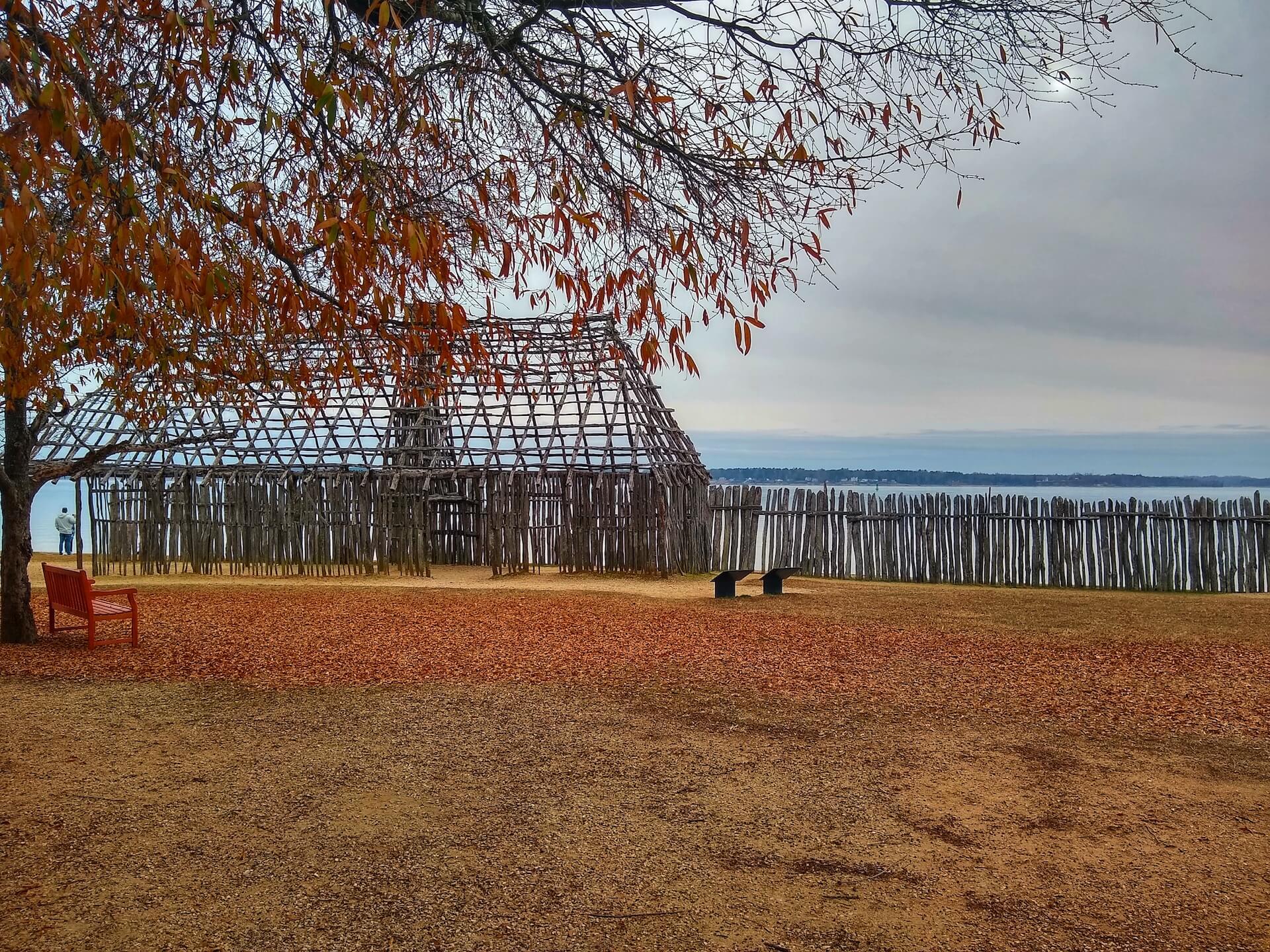
You can purchase tickets ahead of time online or at the Visitor Center, and make sure you pick up a map. The guest services representative will tell you when the next showing of the orientation film is starting (recommended) and what tours or activities are available. National Parks Service rangers are excellent tour guides. They are great at setting the scene and providing important historical context, especially if you’re at a site that requires a bit of imagination, like Historic Jamestowne, where not much remains of the original town.
Regardless of whether you do the tour, use the official map to help you with your visit. It will guide you to important stops such as the hundred-year-old Memorial Church, statues of Pocahontas and John Smith, archaeological dig sites, the site of James Fort, the Voorhees Archaerium, and the Ambler Mansion. The Archaerium displays many artifacts unearthed from the digs around Jamestown Island.
Contributed by Darcy Vierow from Plan, Ready, Go and Follow along on Pinterest
Manassas National Battlefield
The Manassas National Battlefield Park is the site of two major American Civil War Battles. The town of Manassas just to the north of the battlefield was of strategic importance during the Civil War as it was where the Manassas Gap and Orange and Alexandria railroads joined, providing for a direct connection from the Shenandoah Valley and the Washing Richmond Railroad. The Confederate forces won the First Battle of Bull Run and the Second Battle of Bull Run in 1861 and 1862 respectively. It was during the first battle that General Thomas Jonathan Jackson received the nickname ‘Stonewall”, having been compared to one by a fellow officer. The first battle of Bull Run was the first major land battle of the Civil War.

The Manassas National Battlefield Park was established in 1940 and was listed on the National Register of Historic Places in 1966. There is a visitor centre (open from 0830 until 1700) on Sudley Road near the south entrance to the park which includes exhibits Civil War-era uniforms and weapons and a map of the battle areas. The 45 minute Manassas orientation film is a must-see. The site has been preserved much as it was in Civil War times. Entrance to the site and guided tours are free and it is best to experience the site through a guided tour– details here.
Contributed by Sarah Carter of Lets Grow Cook
West Quoddy Lighthouse
Though you wouldn’t guess it from its name, the West Quoddy Head Lighthouse is the easternmost building in the continental United States.
Perched on a peninsula on the northeastern tip of Maine, West Quoddy Headlight is half an hour’s drive from Lubec, a charming fishing town on the Canadian border. The little lighthouse (and its predecessors) have guided ships through the Quaddy Narrows strait dividing the US and Canada since 1808. Lighthouses are essential in any coastal town, but this one was particularly important: thick fog engulfs the area for more than half of the summer. The original lighthouse’s foghorn logged more hours than any other lighthouse in the US in 1885!

Even if you’re not a sailor, there’s more than one reason to navigate your way to the lighthouse. Show up early enough, and you’ll be one of the first people in the US to see the sunrise. Even better, you won’t have to deal with the crowds at the US’ most popular sunrise spot, nearby Acadia National Park. Try to show up at least half an hour before sunrise; the blue hour is almost as beautiful as the golden hour after the sun rises. The entrance to the area is free.
Contributed by Alex of Lost With Purpose Follow along with her on Instagram!
Capitol Building in Washington DC
A list of the top historic sites on the East Coast cannot be complete with one of the most important buildings when it comes to political history. The Capitol.
The Capitol is the meeting point of the House of Representatives and the Senate, and a symbol of the American people and their government. The building was finished in 1800 and has witnessed many historic events ever since. For example, the inauguration of every president, independence day celebrations, or national memorial day concerts.

After Washington D.C. was chosen as the new capital of the US design competition was held for the U.S. Capitol too. Of about 10 entries, the design by William Thornton won. Thornton’s design was inspired by the French Louvre and Pantheon, which explains why the Capitol is a characteristic neoclassic building.
You can learn more about the Capitol, the design, history, and US politics by joining one of the free tours, which you can book in advance if you please or arrange at The Capitol Visitor Center. Besides a tour, you can also explore the visitors center and check out one of the exhibitions, as the Capitol is also a center for American art. Again, visiting these exhibitions and the visitor center are free of charge.
The Capitol Visitor Center is open from 8:30 a.m. to 4:30 p.m. Monday through Saturday, with the last tour leaving at 3.20 p.m.
Make sure you arrive at least 15 minutes before the time of the tour as you need to go through The Capitol security, which may take some time!
Contributed by Lara from Both Feet On The Road, a solo female travel blog written by the clumsiest and worst photographer on earth to give practical and realistic tips on how to travel the world! Follow along with her on Facebook!
Brookgreen Gardens Sculpture Garden
Especially when the display of that art is so unexpected, refreshing, and new to us. Honestly, we’d never heard of most of the American sculptors whose work is displayed at Brookgreen Gardens near Myrtle Beach, South Carolina, and we were so glad to make the introductions.
Brookgreen Gardens, which is designated a National Historical Landmark, contains the largest and most comprehensive collection of American figurative sculpture in the country, with over 2,000 works by 425 artists. It contains almost exclusively figurative art–that is, human and animal figures from nature, history, and mythology. I’m especially fond of figures from the classical mythology field, and there are plenty of those.
Oh, and the gardens and fountains that surround the sculptures are spectacular.

Brookgreen Gardens was founded by railroad heir Archer Milton Huntington and his wife Anna Hyatt Huntington to feature sculptures by Anna and her sister, Harriet Randolph Hyatt Mayor. The sisters made sure the works of other significant American sculptors were also included in the collection. Brookgreen Gardens was opened in 1932, and is built on four former rice plantations.
The famed Huntington Museum, Library, and Gardens in Los Angeles were founded by the same family.
Allow at least several hours to walk the gardens and see the sculpture. If you do it justice, it may even take more than a day. If you have children, or if you’re a child at heart, don’t miss the special exhibits of charming animals and figures designed especially to amuse the young ones.
Adult admission is $18; seniors are $16; children 4-12 are $10; younger children are free. When you arrive, you can exchange tickets purchased online for seven-day passes so you can come back if you miss anything.
Contributed by Tom of Travel Past 50. Follow along with his travels on Facebook
Ellis Island, New York
Ellis Island is one of the most popular historic sites to visit when visiting New York City. Just a short ferry ride away from New York City and Liberty Island is Ellis Island, known as the gateway through which many new immigrants from Europe entered the United States.
The island’s immigration station was in operation and processed immigrants from 1892 to 1954. During this time period, over 12 million immigrants arrived on the island, detained, and questioned before proceeding to their final destination in the United States. It has been said that over half of the American population have at least one person in their family history that has passed through Ellis Island.
Ellis Island is part of the Statue of Liberty National Monument and you can visit both Ellis Island and Statue of Liberty during the same trip. If you’re leaving from Battery Park in New York City, your ferry ticket to Ellis Island covers both with Liberty Island being your first top and Ellis Island the second. Ferry tickets are offered through Liberty Cruises and include admission to Ellis Island as well as the Statue of Liberty. They range between $19 and $22.25 for adults and $9 and $12 for children depending upon which Statue of Liberty admission ticket you chose.
There is so much to see and learn at Ellis Island, it is definitely worth the trip to see!
Contributed by Constance of Adventures of Panda Bear. Follow along with her on Instagram
Women’s Rights National Historic Park
The many exhibits in the Women’s Rights National Historical Park paint the picture of women’s place in US history. The park is a tribute to the suffragists who fought to secure women’s voting rights in the United States. It’s located in the heart of the Finger Lakes region in Seneca Falls, New York. The park is a perfect stop off the New York Thruway when headed to Niagara Falls.
A gathering of animated life-size bronze statues is the first thing you see when you enter the Visitors Center. The statues depict people prominent in the women’s rights and abolition movements. More exhibits upstairs on the political life of women can fascinate for hours.
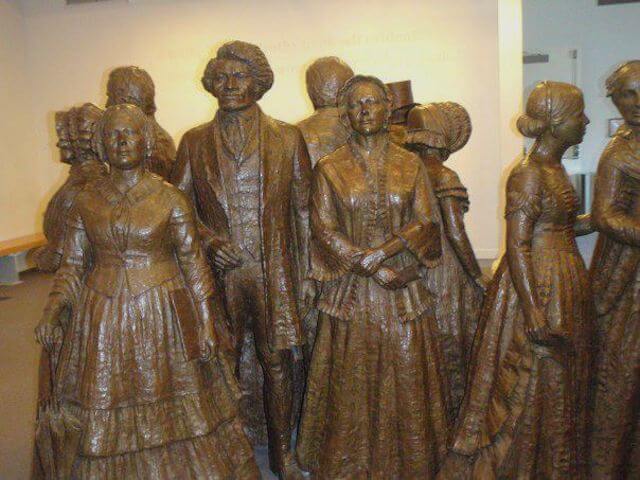
The informative ranger-led tour is worth taking. It takes you past the stunning stone water wall inscribed with the Declaration of Sentiments, a women’s rights take on the Declaration of Independence. Next you will visit the Wesleyan Methodist Church. You will learn about the first Women’s Rights Convention held here in 1848. The convention was the first step in a long journey ending in 1920 with the passage of the 19th Amendment giving women the right to vote.
The home of Elizabeth Cady Stanton, who many consider the main sparkplug for the first convention for women’s rights, is another site to visit. There is also an interesting self-guided walking tour of the historic village of Seneca Falls.
The Women’s Rights Park is a fee-free national park with free entrance and tours. It’s a wonderful place to bring the whole family. The achievements of women striving to gain equality for all promise to inspire everyone.
Contributed by Karen of Outdoor Adventure Sampler and follow along with her on Facebook.
Statue of Liberty, New York
Of all of the East Coast landmarks and attractions, the Statue of Liberty is among the most famous and recognizable symbols of the United States. A UNESCO World Heritage Site since 1984, the Statue is located on Liberty Island in New York Harbor. The Statue depicts Libertas, the Roman goddess of liberty, breaking out of her chains and striding forward. Interestingly, the statue was actually a gift to the United States from the government of France, where it was designed by sculptor Frederic Auguste Bartholdi and constructed by Gustav Eiffel (who would later build the Eiffel Tower). The statue opened in 1886 and now stands as an icon of freedom. New migrants arriving by boat to the United States would pass directly under the statue, and it came to represent the hopes and dreams of a new generation of Americans.
To visit the Statue of Liberty, you’ll need to buy tickets from the National Parks Service which administers the area. From the NPS you’ve got three options: a ferry ticket which provides access to Liberty Island (currently $19.25 for adults, cheaper for children and seniors), a Pedestal ticket which provides access to the statue’s stone pedestal, or a Crown ticket to access the viewing platform inside Lady Liberty’s crown (extra $3). Note that Pedestal and Crown tickets require advance reservations, particularly for Crown tickets. It’s strongly recommended to reserve tickets in advance from the National Parks Service, as many dishonest and aggressive third-party sellers hang around the ferry departure point at Battery Park.
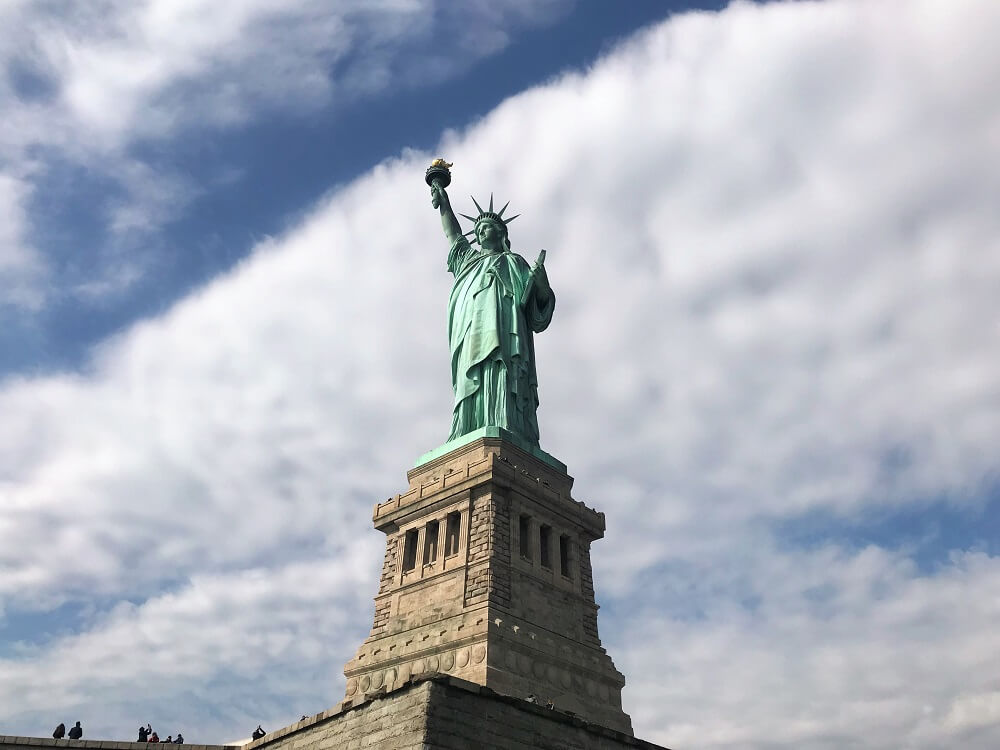
If you’re on a super tight budget and don’t mind just having a close-up view of the statue, there’s also a free option: the Staten Island Ferry which departs every 30 minutes from Whitehall Ferry Terminal in Manhattan. The ferry runs directly past Liberty Island and provides an excellent vantage point.
Contributed by Joel of World Heritage Journey
Booking.comArt Deco Historic District of Miami
The Art Deco Historic District in Miami’s South Beach neighborhood combines vibrant buildings with an equally vibrant atmosphere. The mixture of quirky, colorful buildings built in a combination of iconic Art Deco, Mediterranean Revival, and MiMo (Miami Modern) styles is an architectural feast for the eyes – and a must on any Miami bucket list.
With over 900 buildings, the District boasts the largest concentration of Art Deco architecture in the country. Built between 1923 and 1943, the unique building styles feature ornate statues, geometric fountains, porthole windows, chrome accents, and exotic flora motifs dotting their whimsical pastel walls. In 1979, the District became the first 20th-century neighborhood to be recognized by the National Register of Historic Places.
You can see the colorful District and all of its splendor by walking along Ocean Drive, Collins Avenue, and Washington Avenue between 5th and 23rd streets. To explore the Art Deco Historic District, you can either take a guided walking tour or discover the area on your own. If you choose the latter option, I recommend passing by the Art Deco Museum and Welcome Center on Ocean Drive for more insight on the architectural styles and cultural heritage of the neighborhood.

Be sure not to miss famous buildings such as party central the Clevelander Hotel, the Spanish-style mansion Villa Casaurina – the former home of fashion designer Gianni Versace – and the oceanliner-inspired curves of Señor Frog’s.
If you decide on a walking tour, the Miami Design Preservation League offers a variety of tours depending on your preference. You can choose from the official Art Deco walking tour, a self-guided audio tour, or private group tours.
If you’re looking for something unique in Florida, add the Miami Art Deco Historic District onto your bucket list. With tons of things to see and do, you won’t only learn about Art Deco architecture; you’ll also be inspired by the neighborhood’s buzzing atmosphere.
Contributed by Rosalie of Coastlines to Skylines. Follow along with her on her Instagram!
Kennedy Space Center
Not viewed as a historical site by most people, Kennedy Space Center at Cape Canaveral is absolutely packed with awesome history. For those interested in the history of America’s space exploration, there isn’t a better location to visit in the whole country. Even better, you can still catch rockets blasting off from the launch pads!

You’ll easily be able to see all that Kennedy Space Center offers over the course of a single day. Get there early to avoid some of the crowds and potentially hot or rainy afternoon weather. I’d advise catching the earliest bus tour of the launch sites. This also takes you out to the Apollo/Saturn V museum which is absolutely massive. The sheer size of the Saturn V rocket stored here will leave you speechless and in awe. The Saturn V is the marvelous machine that propelled our brave explorers to the surface of the Moon. The bus tour itself is super informative as well, so enjoy the ride!
Once you’re finished being stunned by the Saturn V, you’ll get the opportunity to explore the Space Shuttle Atlantis. The shuttle program was an amazing feat of American engineering and served to solidify NASA as the premier space agency. Atlantis is a marvel and the fact that you can get so close to something that spent hundreds of days in space is amazing. You’ll also want to pay your respects at the memorial dedicated to the astronauts who lost their lives in the Challenger and Columbia disasters which is located here.
I’ve barely scratched the surface of what you need to see at Kennedy Space Center. Admission prices are $57 for adults and $47 for children. You can also add on the extended bus tour for just $25 which is a great value if you want to extend your day. Kennedy Space Center is a great combination for anyone who loves science and history!
Contributed by Zack of Florida Man on the Run. Follow along with his adventures on Facebook. And read more about responsible heritage tourism on his blog!
Jekyll Island, Georgia
Jekyll Island in south Georgia was once the most home to “the richest, most inaccessible club in the world”. From 1886 to 1942, the Jekyll Island Club operated during the winter month, aka Club Season. The club roster consisted of the most wealthy families in America, like the Rockefellers, Vanderbilts, and Morgans. All winter long, the families would gather in rolling parties, creating powerful alliances, strategic marriages, and countless backroom deals. Two of the most historical events at the Jekyll Island Club were the first transcontinental phone call (along with San Francisco and New York) and the secret meetings to form the Federal Reserve.

During WWII, the club fell into disrepair and ultimately disbanded. In 1947, Governor Melvin E. Thompson gained control of the island for the good of the people of Georgia. The artifacts and furniture from the wealthy homes disappeared, and between mismanagement and human rights complaints about the use of convict labor, the project was a complete failure.
In the mid-eighties, a project began to preserve the history by promoting tourism. Today, the former Club grounds comprise a 240-acre site with 34 historic structures. The Jekyll Island Club National Historic Landmark, one of the largest ongoing restoration projects in the southeastern United States, maintains the 240-acre former Club grounds 240-acre with 34 historic structures. Most of these structures were the winter mansions of the club members.
Visitors today can enter the island for an $8 fee, which gives them access to the historic district. However, a trip to Jekyll Island can be so much more. You can dine in the historic grand dining room or stay as a guest at the Club House or one of several cottages. The Jekyll Island Museum offers a guided tour including entrance to several of the historic structures. Another great way to see Jekyll Island is by bike. There are over 20-miles of Jekyll Island bike trails all through the historic district, as well as the natural areas, which inspired the club’s formation in the first place.
Contributed by Jenn and Ed of Coleman Concierge. Follow along with their adventures on Instagram!
Newport Rhode Island Gilded-Age Mansions
The Gilded Age historical mansions in Newport were built as lavish summer “cottages” in the late 1800s to early 1900s by some of the wealthiest Americans. Families like railroad tycoons, the Vanderbilts designed their 70-room “Breakers” mansion in 1893 with fixtures, furniture, art, and décor from around the world. Ten of these historical sites have been lovingly preserved and are open to the public. They’re all near each other, and many overlook the Atlantic Ocean. When you visit, you’ll see a snapshot of life in the Gilded Age when the upper class went to great lengths to create extravagant displays of wealth. If you take a servant-life tour, you’ll also see the stark contrast between the wealthy owners and the servants that lived, worked and depended on them to survive.
Whatever your interests, you’ll find a variety of tours, exhibits and events covering architecture, landscapes, social life, fashion, design, fine arts, and history at the Newport Mansions. You can purchase tickets online or at any of the homes. Adult tickets start at $18 for 1 property and go up from there, depending on which property or tours and how many you’d like to visit. Allow a minimum of 1 to 2 hours for each one, to enjoy the home tour, grounds and gift shop. Most of the houses are in the Bellevue Avenue-Ochre Point neighborhood of Newport.

Tips: The operating schedule for each house varies seasonally, so plan ahead and check the website to see which homes, tours and hours are available. If you love Christmas, then late November through January 1st is the perfect time to visit and see the homes lit up and decked out in their holiday glitter.
Find out more about Newport Mansions here.
Contributed by Nancy Hann. Follow Nancy Hann at Traveling with Purpose on Instagram
The Museum at Eldridge Street
There is no better place to explore the Jewish history of New York City than the Museum at Eldridge Street! The museum is housed in the historic Eldridge Street Synagogue, one of NYC’s most stunning cultural and historical landmarks. Eldridge opened in 1887 as the first grand synagogue built by the Eastern European Jewish community in the United States. Now, over 125 years later, the museum shares the story of the millions of Jewish immigrants who moved to New York in search of a better life and new opportunities in a new land. Eldridge offers guided tours starting hourly. The guides are true subject matter experts and many actually have a personal connection to the museum or neighborhood! Even better: the tour is already included in the admission price!

On the ground floor of the museum is a small permanent exhibit and digital tables showcasing the building’s history and an introduction to Jewish beliefs and practices. More than just a history museum, Eldridge is truly an architectural masterpiece. Walk into the main sanctuary and take a step back in time to the turn of the 20th century. Meticulously restored walls painted in a trompe l’oeil marble design, original pine floorboards and even stained glass windows that the NY Times have described as ‘gasp-inducing’. The star of Eldridge Street is actually one of the newest additions to space: the contemporary stained glass window designed by artist Kiki Smith and architect Deborah Gans. Like the dynamic nature of New York’s ever-changing cityscape, the vibrance of this window reminds us that even historic sites like Eldridge are still alive and vivacious over 100 years later! If you’re on a budget, Mondays are ‘Pay As You Wish’. Visitors of all backgrounds and faiths are welcomed with open arms, and visiting is a great opportunity to learn more about Jewish practice and synagogue architecture. Note the museum is closed on Saturdays and Jewish holidays. Check the website before planning your visit.
Adults: $15
Students & Seniors: $10
Children 5-17: $8 (under 5 are free)
Contributed by Courtney of Courtney in the Middle Seat
Fort Jefferson, Florida
Dry Tortugas National Park is one of the most remote National Parks in the US. It is located around 80 miles southwest of Key West, Florida.
Within the Dry Tortugas National Park lies an imposing Fort Jefferson, one of the most strategic fortress to defend the United States of America. Its location was chosen to protect both the Gulf of Mexico and Straits of Florida from approaching enemies ships. Even though it has never seen a battle, Fort Jefferson has assisted many ship routes, including the Spanish-American War in 1898.
Construction started in 1846 for the next thirty years with bricks brought from both sides of the US during the Civil War. Upon completion, Fort Jefferson holds the title of the largest brick masonry structure in the Americas.
You can join in the complimentary guided tour of Fort Jefferson, led by the Parks Ranger. Or, if you opt to enjoy the natural beauty of Dry Tortugas, you can do some popular water and beach activities, including snorkeling in some of the most pristine environments Florida can offer.
There are only two common ways to get to Dry Tortugas National Park from Key West. Fly with a seaplane costs around $356-625 roundtrip, or the most popular one with a Yankee Freedom III ferry for $180. Both will require you at least half a day to do.
Contributed by Halef and Michael of Around the World Guys. Check out their adventures on their Youtube Channel!
Are you ready to plan your trip to some amazing historical sites on the East Coast?


Start Planning Your Next Trip!
- Plan the best weekend getaway ever!
- How to perfectly pack everything for your next trip
- How to prepare for any trip
- Book your accommodation: For booking hotels, we like to use Hotels, Booking, and Agoda. For more unique stays, we like to use Airbnb.
- Book your flights: For booking flights, we like to use Kiwi or Student Universe to check for deals.
- Activities and tours: Our go-to resources for booking activities and tours are: Groupon, GetYourGuide, and Viator. Also, check if your city is available on CityPass for extra discounts.
- Luggage: When we travel, we love using our SwissGear Energie series luggage set. This hardshell luggage is lightweight, spacious, and affordable! We love how much of our stuff can fit in this luggage.










